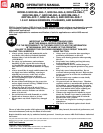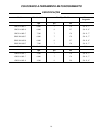
M10
180
2
WARNING LABEL IDENTIFICATION
FAILURE TO OBSERVE THE FOLLOWING WARNINGS COULD RESULT IN INJURY.
Always wear eye protection
when operating or perform-
ing maintenance on this
tool.
WARNING
WARNING
Always wear hearing
protection when operating
this tool.
Always turn off the air sup-
ply and disconnect the air
supply hose before instal-
ling, removing or adjusting
any accessory on this tool,
or before performing any
maintenance on this tool.
WARNING
Air powered tools can vibrate
in use. Vibration, repetitive
motions or uncomfortable
positions may be harmful to
your hands and arms. Stop
using any tool if discomfort,
tingling feeling or pain occurs.
Seek medical advice before re-
suming use.
WARNING
Do not carry the tool by
the hose.
WARNING
WARNING
Do not use damaged, frayed
or deteriorated air hoses
and fittings.
WARNING
Keep body stance balanced
and firm. Do not overreach
when operating this tool.
WARNING
Operate at 90 psig (6.2 bar/
620 kPa) Maximum air pressure.
90 psig
(6.2bar/620kPa)
GRINDER SPECIFIC WARNINGS
FAILURE TO OBSERVE THE FOLLOWING WARNINGS COULD RESULT IN INJURY.
• Do not use this tool if actual free speed exceeds the
nameplate rpm.
• Before mounting a wheel, after any tool repair or
whenever a Grinder is issued for use, check free
speed of Grinder with a tachometer to make certain
its actual speed at 90 psig (6.2 bar/620 kPa) does not
exceed rpm stamped or printed on the nameplate.
Grinders in use on the job must be similarly
checked at least once each shift.
• Always use the recommended ARO Wheel Guard
furnished with the Grinder.
• Do not use any grinding wheel, bur or other
accessory having a maximum operating speed less
than the free speed of the Grinder in which it is
being used. Always conform to maximum rpm on
grinding wheel blotters.
• Inspect all grinding wheels for chips or cracks prior
to mounting. Do not use a wheel that is chipped or
cracked or otherwise damaged. Do not use a wheel
that has been soaked in water or any other liquid.
• Make certain grinding wheel properly fits the
arbor. Do not use reducing bushings to adapt a
wheel to any arbor unless such bushings are
supplied by and recommended by the wheel
manufacturer.
• After mounting a new wheel, hold the Grinder
under a steel workbench or inside a casting and run
it for at least 60 seconds. Make certain no one is
within the operating plane of the grinding wheel. If
a wheel is defective, improperly mounted or the
wrong size and speed, this is the time it will usually
fail.
• When starting with a cold wheel, apply it to the
work slowly until the wheel gradually warms up.
Make smooth contact with the work and avoid
any bumping action or excessive pressure.
• Always replace a damaged, bent or severely worn
wheel guard. Do not use a wheel guard that has
been subjected to a wheel failure.
• Make certain wheel flanges are at least 1/3 the
diameter of grinding wheel, free of nicks, burrs and
sharp edges. Always use wheel flanges furnished by
the manufacturer; never use a makeshift flange or a
plain washer. Tighten Flange Nut securely.
• Guard opening must face away from operator.
Bottom of wheel must not project beyond guard.
• Always match collet size with accessory shank size.
• Always insert tool shank no less than 10 mm in the
collet. Tighten Collet Nut securely to prevent
accessory from working out during operation of the
Grinder. Check tightness of Collet Nut before
operating the Grinder. Pay particular attention to
the fact that allowed speed of a mounted point is
lowered when the length of the shaft is increased
between end of collet and mounted point
(overhang).


















